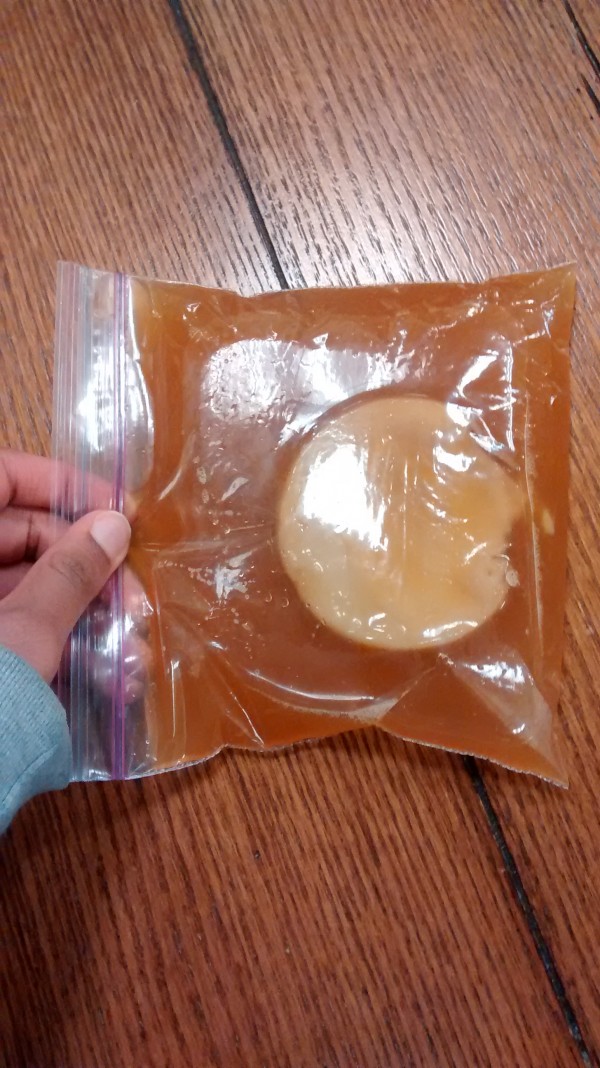
Kombucha mushroom is known as an “immortal health elixir” as it prevents and fights cancer, arthritis and other degenerative diseases. One of kombucha’s greatest health benefits is its ability to detox the body. It is a probiotic, which can improve digestion and reduce or eliminate symptoms of fibromyalgia, depression and anxiety.

| Servings |
|
- 1 1/2 tsp loose tea or 2 tea bags
- 1/4 cup sugar
- 2-3 cups filtered water
- 1/2 cup kombucha starter tea or 1 tbsp apple cider vinegar
- 1 tbsp loose tea or 4 tea bags
- 1/2 cup sugar
- 6-7 cups filtered water
- 1 cup kombucha starter tea or 1.5 tbsp apple cider vinegar
- 2 tbsp loose tea or 8 tea bags
- 1 cup sugar
- 13-14 cups filtered water
- 2 cups kombucha starter tea or 3 tbsp apple cider vinegar
Ingredients
For a 1 quart container
For a half-gallon container
For a gallon container
|

|
- Boil 1/4 of the amount of water with the amount of sugar.
- Stir until the sugar dissolves.
- Remove from burner, add tea bags and let steep for about 10 minutes.
- Pour into a jar and add remaining amount of cold water. (The tea solution MUST be cooled before adding scoby kombucha mushroom).
- Ferment for 2 weeks. An ideal culturing spot should be relatively warm - but not excessively so. Temperatures between 70 and 80 degrees F are ideal. The best fermenting spot is out of direct sunlight and has reasonably good airflow (as access to oxygen benefits the fermentation process). DO NOT DISTURB! It is important to allow the kombucha to ferment undisturbed for 2 weeks.
Hygiene
When working with kombucha, it is important to wash and rinse your hands well prior to working with the tea mixture or the scoby. Also thoroughly clean and rinse the container and all utensils that will come in contact with the scoby. Beware of soap and food residue that the dishwasher may have missed. When in doubt, give everything an extra rinse. Glass containers are best!
Formation of a new “baby” scoby
The process begins as a layer of film developing on the surface of the liquid. Generally the layer will start off clear,but over the period of a few days or a week, it will become hazy and then less and less translucent, more white, and slowly thicker until it resembles the scoby you used to culture the batch.
Normal Variations vs. Signs of problems
Normal Varations: Each batch of kombucha is unique and therefore may not process exactly as the previous batch. Some common variations include:
- The scoby may float, sink to the bottom, hover in the middle of the brew. None of these positions indicate any sort of problems.
- You may see a brown stringy substance floating in the container, brown blobs clinging to the scoby, or dark sediment forming in the bottom of the container. These are by-products of the yeast culturing the liquid.
- If the jar is disturbed or vibrates, or sometimes for unknown reasons, the new forming baby scoby may detach from the surface area and sink to the bottom or otherwise float in the liquid.
- Depending on the position of the scoby used to ferment the batch, sometimes the original scoby will attach and fuse to the newly developing scoby. Once the batch is complete, you can separate them by tearing them apart (do not use metal such as knife or scissors).
Signs of Potential Problems (MOLD):
If appropriate varieties of water, tea and sugar are used, and the starter tea or vinegar is added, the acidic nature of the brew makes it very uncommon for mold to develop. In fact, the most common cause of mold is forgetting an ingredient or using improper ingredient ratios that alter the acidic level of the brew. However unlikely, mold can and occasionally does develop and can generally be seen by the formation of white, green, orange, red or black spots on the scoby. Other potential causes of mold include:
- Contamination from soap or food residue on the jar or utensils used to prepare the mixture.
- Mold spores on the tea used to brew the kombucha.
- Transient yeasts and bacteria in the air or poor hygiene practices when preparing the mixture.
- Allowing your kombucha to ferment too close to a garbage can be a source of transient bacteria.
- Allowing your kombucha to ferment too close to other fermented foods or rising bread made with commercial baking yeast.
- Mold spores in the air from a humid environment – such as a kitchen or bathroom or in the air ducts.
If mold does develop, immediately toss the entire batch, including the scoby. Do not try to salvage a moldy batch or a moldy scoby. Obtain a new scoby, clean the jar thoroughly, and try again.
Pests
Fermenting kombucha is very attractive to ants and fruit flies which is why it is recommended to use a tight-weave cover and securing the cover with a tight rubber band to keep invaders out. If you find worms (maggots) have infested your scoby, this is a sign that fruit or house flies have invaded and laid their eggs. If this happens, immediately toss the entire batch, including the scoby. Do not try to salvage a moldy batch or a moldy scoby. Obtain a new scoby, clean the jar thoroughly, and try again.
Black Scoby
A black scoby (or black parts) is a sign that the scoby has died. If this happens, toss the scoby, and start again with a new one.
Taste of kombucha doesn’t change
If you find that your kombucha does not seem to be fermenting, first determine if the place it has been sitting is too cool. (Consider temperature shifts at night). Often the problem can be resolved by moving the container to a warmer location.
Safety first
This information is provided as suggestions only and does not substitute for using good judgement. Never consume any kombucha that looks, tastes, or smells unpleasant!
Harvesting your kombucha
Congrats! You’ve brewed your first batch. Now comes the fun part: harvesting and enjoying your brew.
- Removing the scobys (both of them): Prior to harvesting your batch, prepare a new mixture so you will have a place to put both the original scoby and the baby scoby that may have formed during the fermentation process.
- Straining: Before drinking, strain the kombucha through a fine mesh plastic strainer.
- Flavoring: If desired, the tea can be flavored at this point, using 100% fruit juice, herbs and more.
- Bottling: If desired, the kombucha can be bottled for consumption at a later date. If using air tight bottles, bottling kombucha can serve a secondary purpose beyond storage as the active yeast and bacteria will continue to consume the remaining tea and sugar in the brew but at a much slower rate. Use extreme caution when opening the bottle, as the contents are most likely under pressure.
I refrigerate mine as I like it cold, and already premixed with Cranberry juice.










Off